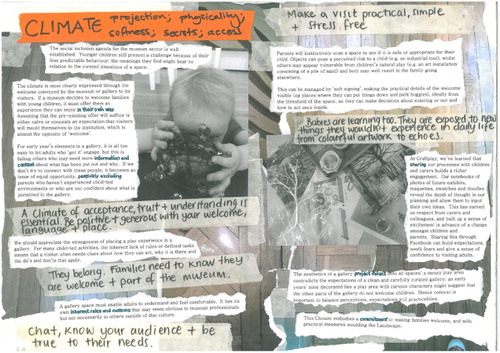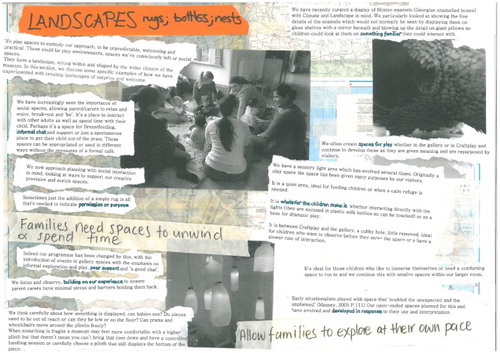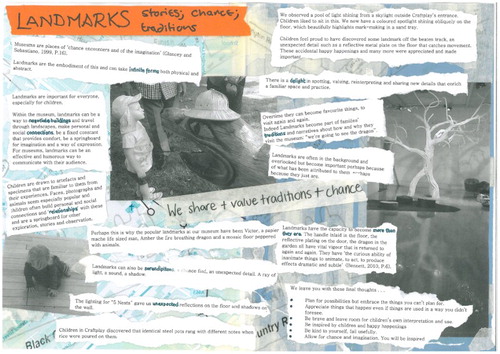Introduction
In this visual essay we explore children’s Spaces In-between; the often overlooked space between formal creative delivery and museum provision.
As play artists we drew on our experience and ability to experiment, investigating spaces that we created for children and spaces that were appropriated by them.
We first developed the term Spaces In-between while observing how children used a play space, navigating between entering and interacting with the room, as well as children taking delight in the empty floor space between different areas.
Eventually this phrase grew to encompass other Spaces In-between the expected or traditional provision in a museum, whether physical or intangible, planned or accidental.
Writing for Children’s Geographies, we found ourselves using an appropriate metaphor to structure our thoughts. The Climate is a set of conditions that go towards making a museum or gallery space truly welcoming to families with young children. Climate shapes the Landscape, the physical space manifesting the qualities that make people want to be there. Landmarks are the way we discover and map a landscape, and the surprises and lures that make us return.
By welcoming the unexpected, and letting it influence our work in the moment and in our planning, our approach is inherently rhizomatic, where every level of a hierarchy of planning and delivery can be productively disrupted.
The format of our essay reflects this, with layers of meaning, inviting readers to navigate the essay in different ways and allowing for different entry points into the text. We have listed points of emerging values on masking tape and highlighted significant words in blue to enhance the narrative.
Our language is naturally rich and overly descriptive as we inspire and communicate with families. We rejoice in the new layers of meaning that children create and assimilate children’s language into our own. We have used this voice throughout our visual essay.
In this process we came across what is often referred to as ‘inbetween spaces’, intermediate spaces between buildings and the street, and realised that this was similar to spaces being created by the placement of plinths for example. However, our Spaces In-between are not limited to these but also include things that are not purposely curated as well as the environment and mood.
The authors
Elizabeth Clayton and Jack Shuttleworth are freelance artists working with young children and families through action research and reflective practice.
Until recently we ran and developed Craftplay the specialist early years project at Bilston Craft Gallery, Wolverhampton UK.
Over the past 15 years, the project has had a close relationship to the gallery’s exhibition programme and has developed an agenda for accessibility and engagement. This ranges from the nature of the welcome to a space, practical issues of access and how meaning is made in a museum environment.
Craftplay used a richly equipped creative play space adjoining the public galleries, running sessions with families or visiting groups which often incorporate visits or play in the exhibitions.
We have worked with families over a number of years allowing us a deep understanding of their needs and developing unprecedented insights into families visiting heritage venues.
This article has emerged from observations of how children, particularly in families, interact with gallery spaces and includes design considerations we believe to be core essentials and other ideas we would hope to use in the future.




Afterword
Elizabeth Clayton is a freelance play artist and early years specialist working with Craftplay since 2004. Working with local families has led to an exceptional understanding of parents and children in a museum and creative play environment. She has a particular interest in exploring natural play engagement, creating ‘supportive museum spaces’ and establishing dialogues between museums and their audiences.
Jack Shuttleworth spent 15 years in the Theatre in Education movement and then focussed on inclusion and equalities in the museums sector. He is passionate about access, especially for early years, and also has a strong interest in the role emerging cultural forms (digital art, contemporary cartographies, web 2.0) can play to support diversity in the sector.
Craftplay is part of Wolverhampton City Councils’ Arts and Heritage service and funded by Arts Council England.
Acknowledgements
We would like to acknowledge the influence and support of Nikki Pugh and Paul Conneally’s Splacist Manifesto V2.0, Dr Abigail Hackett and Paula Kovacs.
Disclosure statement
No potential conflict of interest was reported by the authors.
References
- Bennett, J. 2010. Vibrant Matter: A Political Ecology of Things. Durham, NC: Duke University Press.
- Debord, G. 2015. “The Theory of Dérive.” In The Improvisation Studies Reader: Spontaneous Arts, edited by R. Cains and A. Heble, 176. Oxon: Routledge.
- Glancey, J., and S. Brandolini. 1999. “Aldo Van Eyck: The Urban Space Man.” Guardian.
- Massey, D. 2005. For Space. London: Sage.
